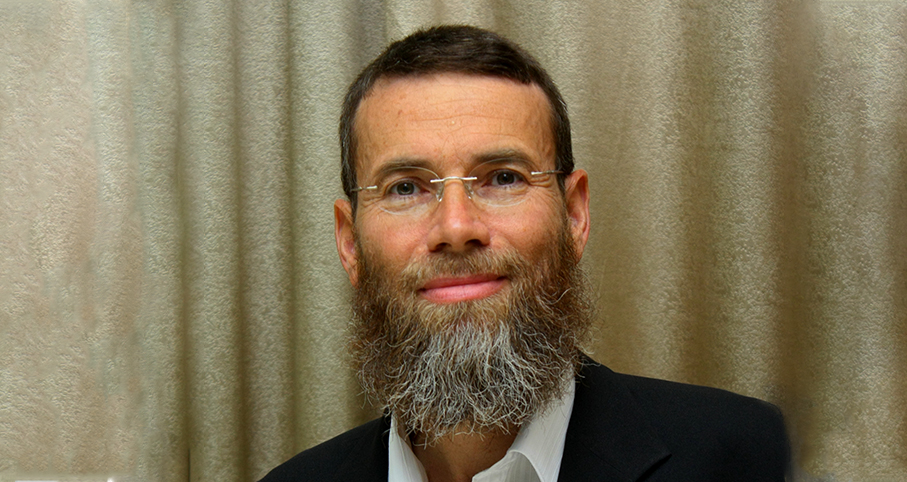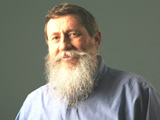Beit Midrash
- Shabbat and Holidays
- Rosh Hashana
- Halachot for Rosh Hashana
"The Shemoneh Esrei on Rosh Hashanah is very long. Is it sufficient that I stand with my heels touching, or must my feet be side-by-side touching their entire length?"
Question #2: Standing straight
"Why do we keep our feet together during kedushah but not when responding to kaddish?"
Question #3: Kaddish together
"Is it required to have one’s feet together when reciting kaddish?"
Answer:
Fulfilling the mitzvah of davening requires that we observe many halachic details. The Rambam organizes these laws under two headings: essential and non-essential components. In Chapter 4 of Hilchos Tefillah, he lists five essential components of prayer, meaning the Shemoneh Esrei. These are:
1) Cleansing one’s hands before prayer
2) Having one’s body properly covered
3) Praying must be in a place that is clean and without inappropriate odor
4) Not davening when one senses bodily needs
5) Having basic, proper intent and focus
The Rambam calls these five requirements "essential," which means that a prayer missing any of these qualities does not fulfill the mitzvah and one is required to recite it again. Someone who cannot meet these requirements is exempt from praying until he can meet them. Therefore, it is preferred that someone unable to fulfill the basics of these requirements miss the prayer rather than recite a tefillah that violates these laws. Many of these topics are available for reading or downloading on RabbiKaganoff.com
Non-essentials
In Chapter 5 of Hilchos Tefillah, the Rambam lists eight non-essential components of prayer, meaning that these are important aspects, but one fulfills the mitzvah to pray even if they are entirely missing. These eight aspects are:
1. Standing during prayer
2. Facing the Beis Hamikdash
3. Correct positioning
4. Appropriate attire
5. Proper location
6. Volume
7. Bowing
8. Prostrating
The Rambam notes that these requirements are not essential, and that, therefore, someone who failed or was unable to do them has fulfilled the mitzvah to daven. Furthermore, one who is unable to fulfill any of these aspects should daven anyway. Therefore, although davening while properly attired is very important, one who will be unable to dress appropriately should daven and observes this law only to the extent that he can under the circumstances.
Correct positioning
One article cannot cover all the laws of these rules, so here we will discuss one aspect of the requirement to position one’s body in a certain way. The Rambam (Hilchos Tefillah 5:4) states the following aspects of positioning one’s body:
When standing to daven shemoneh esrei, one’s feet should be together and alongside one another.
One’s eyes should be facing downward, yet his heart should be directed upward, as if he is standing in heaven.
One’s hands should be resting on one’s heart, with the right hand atop the left, standing in fear and awe like a servant before his master.
One should not place his hands on his hips.
As I mentioned above, although these factors are important components of proper prayer, they are not essential, and one who neglected to do them has fulfilled the requirement to pray (see Mishnah Berurah 95:1; Kaf Hachayim 95:2). Therefore, someone who cannot put his feet together should daven without his feet together, rather than not daven at all (Kaf Hachayim 95:3).
Feet together
The Rambam states: "When standing to daven shemoneh esrei, one’s feet should be together and alongside one another." The basis for this ruling is the Gemara (Brachos 10b) which mentions this requirement based on the following. In Yechezkel’s opening prophecy, he shares with us a vision of the heavenly courts, describing the feet of the angels as veragleihem regel yesharah, literally, "their feet were a straight foot" (Yechezkel 1:7). According to Targum and one interpretation of Rashi, the verse means that the angels stood in a way that their feet lay one alongside the other. The Gemara explains that when we daven we should also have our feet aligned, which Rashi explains to mean that one foot should be alongside the other so that they appear as one "foot."
This passage of Gemara leaves one puzzled. Indeed, Yechezkel reports to us that the angels stood with their feet together. But why is a person who is praying required to emulate the position of the angels? Are we also required to pray while flying, as the angels sometimes do?
A simple approach
On a simple level, one could explain that standing with one’s feet together makes one feel somewhat vulnerable and therefore humble, and that this position allows one to fulfill davening with trepidation and humility (Levush, Orach Chayim 95:1). However, although this approach seems to supply a good reason for us to have our feet together when we pray, it does not seem to explain what the Gemara was saying since this has nothing to do with the fact that the angels stand this way.
The latter question is discussed by an early commentator, the Rashba (in his commentary to the Gemara Brachos), who writes the following:
"I was asked by someone who is an enemy of our people [probably someone trying to proselytize among the Jewish people]: Why do we keep our feet together when we pray, and what proof is being brought from the holy bearers of the divine chariot to someone praying?
"I responded as follows: ‘There are two major reasons for this. The first reason is that man’s body was created with limbs -- his hands and legs -- whose purpose is to enable him to reach and acquire what he wants and to distance himself from harm. The hands bring him items of pleasure, push away from him harmful items, and are what he uses against his enemy in warfare. His feet move him great distances in a very short time, and enable him to escape from harm.
"It is essential to prayer that a person realize that none of these abilities are man’s own activities and they will not save him without G-d’s help. Everything is dependent on G-d’s will. In order to entrench this idea in one’s soul, one must place one’s feet together when praying, to symbolize that his feet are completely bound and paralyzed. They are without any ability to flee from danger. This forces man to realize that all his abilities of locomotion are only because G-d helps him." This reason is quoted by the Beis Yosef, Orach Chayim 95 in the name of a much later authority, the Mahari Abohav.
The Rashba continues: "The same is true with one’s hands. The Gemara teaches that in times of difficulty, Rava would fold his arms when he prayed... This position demonstrates that it is as if one’s arms are bound and one is without help except for Hashem."
The Rashba then adds: "There is another reason why we assume the position of the angels when we pray: The human species, whose purpose is to recognize the Creator and to praise He who created man from nothing, has a specific responsibility to serve G-d and to keep His commandments. Man is an angel, an emissary, placed on earth, just as the celestial angels serve and recognize their Creator. Mankind can therefore be called malach" (as he is in Malachi 2:7), which means G-d’s messenger. Thus, the Rashba explains that placing one’s feet together, whether performed by man or by angels, demonstrates a lack of ability, thereby recognizing that all our strength at all times comes from Hashem. We are also showing that we are, indeed, comparable to angels, since we are fulfilling G-d’s mission on Earth. To quote the Zohar (parshas Pinchas #229), "The Holy One, blessed is He, said: Those who pray with their feet together like the angels, I will open the gates of the Sanctuary for them to enter."
There is yet another reason why we pray with our feet touching, side-by-side, which is that when we are talking to Hashem, it is essential that we be fully and exclusively focused. This places us on the levels of the angels who are always focused exclusively on their Divine mission.
Is regel a foot?
After explaining why we pray in a position similar to that of the angels, the Rashba adds: "You should realize that the word regel has a double meaning, for it means not only the foot but it also means cause (as in Bereishis 33:14 and 30:30). According to this interpretation, the verse in Yechezkel 1:7, veragleihem regel yesharah, should be translated as their cause is a straight cause, meaning that the angels consistently follow the path of truth.
"In this manner, someone standing and praying before Hashem must abandon thoughts of himself, and focus completely on the prayer he is reciting. Concentrating all his energies on this goal develops him such that everything he does, all the time, should be only for the purpose of strengthening his body in order to serve Hashem. Placing his legs together demonstrates having a straightforward cause directed toward the purpose for which he was created -- to serve G-d. For this reason, man can be compared to the chariot that bears Hashem’s presence into the world."
Should the front of the toes be separated?
Having established the basis for the practice that one’s feet should be together when reciting shemoneh esrei, we find a discussion in the rishonim whether the feet should be slightly separated in front. Rabbeinu Yonah quotes some who hold that the tips of both feet should not touch, so that it appears like a calf’s foot with its split hooves. Rabbeinu Yonah disputes this, saying that the requirement is only that the feet be together like one foot — there is no mention of making one’s feet look like a split hoof.
Nevertheless, we still find a dispute among early acharonim whether one should lechatchilah stand with a slight split at the front of one’s toes or not. The Olas Tamid writes that this is preferred. However, the Yeshuos Yaakov disagrees, contending that one should not have one’s feet slightly separate. He notes that the angels cover their feet that look like those of a calf so as not to be reminiscent of the eigel hazahav, the Golden Calf. Therefore, we should deliberately not have our feet look like this, reasons the Yeshuos Yaakov.
The Yerushalmi
Having quoted the passage of the Talmud Bavli that explains how we should stand when we pray, we should be aware that there is also a passage of Talmud Yerushalmi (Brachos 1:1) regarding this issue. There, the Yerushalmi quotes a dispute between Rabbi Levi and Rabbi Simon, one of whom held the same opinion as the Bavli that one should daven with one’s feet pressed together and the other holding that, when davening, one should assume the position that the kohanim did when walking in the Beis Hamikdash. There, the kohanim took very small steps such that the big toe of one foot was next to the heel of the other when they walked.
Since in a dispute between the Talmud Bavli and the Talmud Yerushalmi we rule according to the Bavli, it would appear that the dispute recorded by the Yerushalmi is halachically irrelevant. The commentaries are thus surprised to note that the Tur quotes the Yerushalmi, leading the Beis Yosef and the other commentaries to question why the Tur does so. Many answers are proposed to explain the Tur’s position. I will quote here two of them, whose answers yield halachic ramifications.
The Bach explains as follows: In his opinion, halachah requires that one daven with one’s feet in one of the two positions advocated by the Yerushalmi. The Bach contends that if one’s feet are in neither of these positions one has not fulfilled the requirements of prayer. The Tur agrees that it is preferable to place one’s feet alongside one another, since we rule as the Bavli does. However, he quotes the Yerushalmi because someone who failed to position his feet in either of these positions is required to daven again. Furthermore, someone who cannot align his feet alongside one another should position them so that the toe of one foot is alongside the heel of the other. Thus, although we follow the ruling of the Bavli that one should daven with the two feet alongside one another, it is also important to know the conclusion of the Yerushalmi, which is why the Tur included this information.
Several authorities note that, according to this approach, the Tur’s interpretation of the topic has him in dispute with the Rambam’s ruling, quoted above, that positioning is never essential to prayer, and that one fulfills the mitzvah of davening with one’s feet in any position. Since they see no evidence that such a dispute exists, they are reticent to create one on this basis and instead suggest other approaches to resolve why the Tur quoted the Yerushalmi. Notwithstanding this conclusion, some authorities opine that someone who davened with his feet apart should daven a voluntary prayer (called a tefilas nedavah), to make certain that he fulfilled the mitzvah (Olas Tamid). Later authorities reject this approach and rule that one should assume that he fulfilled the mitzvah (Kaf Hachayim).
Another approach
The Aruch Hashulchan suggests a different explanation why the Tur presented the Yerushalmi’s discussion. He explains that the Tur wants us to realize that someone who is unable to have his feet together for whatever reason, but who can assume the alternative position of having his toe touching his heel, should daven in the latter position. According to this approach, everyone accepts that these rules are all only lechatchilah and that one who davened with his feet in a completely different position has fulfilled the mitzvah, bedi’evid, after the fact.
Sitting with your feet together?
Is someone who must pray from a sitting position, either because of health reasons or because of travel, required to daven with his feet together? The Pri Megadim rules that he should still keep his feet together while davening. He further explains that someone who must daven while sitting should not lean backwards or to the sides while praying, and should also be careful not to stretch or cross his legs while davening, because these positions all convey an air of conceit.
All or nothing?
At this point, let us refer to the first question with which I opened our article: "The Shemoneh Esrei on Rosh Hashanah is very long. Is it sufficient that I stand with my heels touching, or must my feet be side-by-side touching their entire length?"
From what we have seen, it is clear that the proper position for davening is to have one’s feet side-by-side and touching their entire length.
Kedushah
At this point, let us address the remaining of our opening questions:
"Why do we stand with our feet together during kedushah but not when responding to kaddish?"
"Is it required to have one’s feet together when reciting kaddish?"
By way of introduction, let me quote a discussion from a late rishon, the Terumas Hadeshen (#28). He quotes the following question:
"Should an individual align his feet when he responds to the chazzan’s kedushah?"
To which he answers, "It appears to me that he should, since the prayer states, We shall sanctify his name just as they sanctify His Name in the highest heavens, and in the heavens they recite the kedushah with a ‘straight foot,’ as the verse reads ‘their feet were a straight foot.’ We should attempt to act like the angels to the best of our ability; there is neither conceit nor foolishness in our doing so. Indeed, this is the proper way to act." This answer of the Terumas Hadeshen is quoted subsequently by all the authorities, and is codified in the Shulchan Aruch (Orach Chayim 95:4).
Borchu
Although none of the reasons mentioned above applies to reciting Borchu, that is, we are not trying to compare ourselves to angels, nor is it the ultimate prayer; nevertheless, the custom is that Borchu is recited with one’s feet together. This custom is recorded by some late authorities (Aruch Hashulchan). Therefore, one should align one’s feet when reciting Borchu. However, since there is no halachic source that requires reciting Borchu with one’s feet together, one should not admonish someone who recites Borchu with his feet apart.
Kaddish
I have found no early source that requires one to have one’s feet together while reciting kaddish. Although it is standard practice that people recite kaddish with their feet together, since there does not appear to be an early halachic source for this practice, one should not admonish someone who fails to do so.
Conclusion
Understanding how much Chazal were concerned about the relatively minor aspects of davening, such as how we position our feet, should make us more aware of the fact that davening is our attempt at building a relationship with Hashem. As the Kuzari notes, every day should have three very high points -- the three times that we daven, and from these three prayers we gain our strength and inspiration for the rest of the day.
Many articles on various Rosh Hashanah topics are available for reading or downloading at Rabbikaganoff.com under the headings "Rosh Hashanah," "Shofar" or "Tashlich."

Appreciating Tashlich
Rabbi Yirmiyohu Kaganoff | 25 Elul 5783

Children Hearing Shofar Blowing
Rabbi Daniel Mann | Elul 24 5781

Checking the Simanim for Rosh Hashana 5783
According to Sefer Bedikas Hamazon by Rav Vaye
Rabbi Moshe Vaya | 5783

























